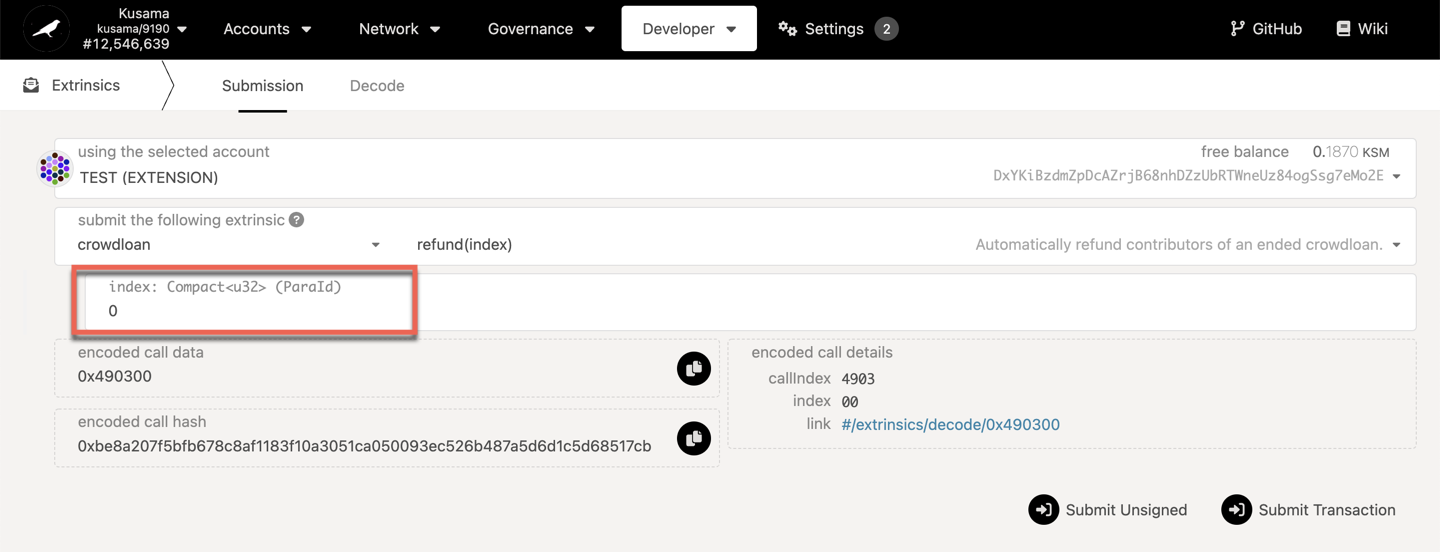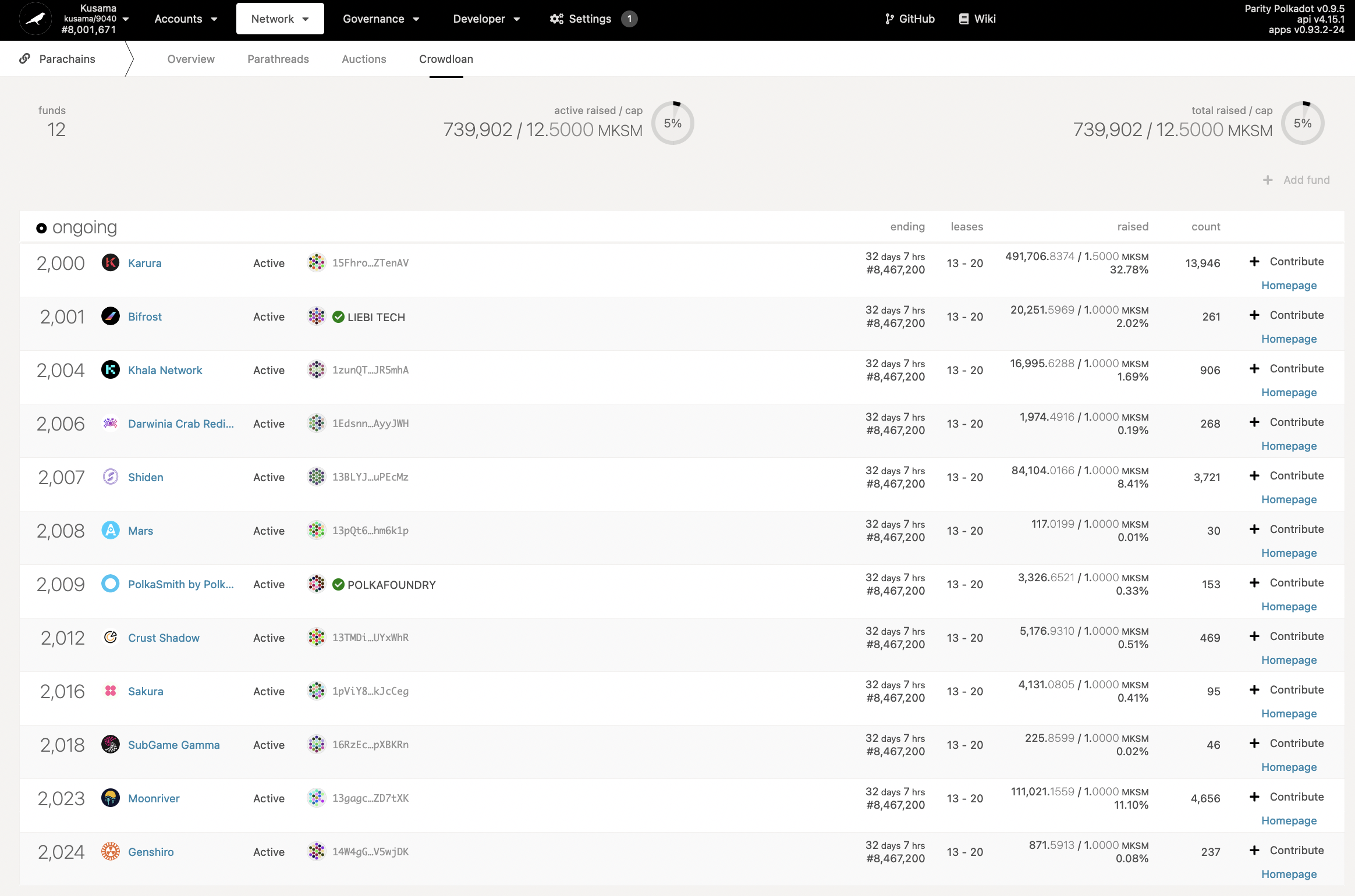Parachain Crowdloans
Polkadot allows parachains to source tokens for their parachain bids in a decentralized crowdloan.
If you are here for guidance on how to contribute to a crowdloan, watch the video below or read this support article on crowdloans.
Crowdloan Campaigns vs Parachain Auctions
It is important to recognize that starting a crowdloan campaign is optional for participating in a parachain slot auction. The parachain slot auction can also be won directly through self-funding without community involvement. To reiterate, crowdloan campaigns are just one of the means to win auctions, which allow the community to participate in a trustless and permissionless way.
Let's look at a scenario where Project A is bidding for a parachain slot, but they don't have enough tokens to bid directly to win the parachain auction. Project A could benefit from starting a new crowdloan campaign to help secure a parachain slot. Crowdloans are trustless and are supported natively on the relay chain, allowing the community to bond their tokens on Project A's behalf for the entire parachain lease duration. This will allow Project A to compete with projects that may have access to greater capital, given the project has sufficient community support. In return, the community contributors are rewarded by the projects that win the parachain slot, which would compensate for the opportunity cost of bonding their tokens for the lease duration.
On the other hand, let's say Project B, which is more established and has access to capital, is hoping to secure a parachain slot through self-funding. Project B is not relying on community funding (at least via the crowdloan mechanism), so they must determine how much funding they can allocate towards winning a slot.
Project B fully controls how much they are willing to contribute to gaining a parachain slot. Project B need not work on creating a reward model for community contributors like Project A. In contrast, crowdloan campaigns benefit projects with access to limited capital but have strong community support. They are also beneficial for projects that can successfully bid to win the auction with self-funding but are looking for a mechanism to bootstrap their community and get noticed by the key actors in the ecosystem.
It is publicly visible on-chain whether or not a project is bidding directly or through a crowdloan campaign. More details regarding creating and executing a crowdloan campaign are provided below.
Starting a Crowdloan Campaign
Anyone who has registered a parachain can create a new crowdloan campaign for a slot by depositing a specified number of tokens. A campaign is configured as a range of slots (i.e. the duration of the parachain will bid for), a cap, and a duration. The duration can last over several auctions as long as the range of slots matches those of the auction (i.e. the first lease period of the crowdloan is the same or bigger than that of the auction). This means a team will not need to restart the campaign just because they do not secure a slot on their first attempt.
To create a new crowdloan campaign, your account must have 500 DOT (or 100 KSM on Kusama) transferrable which will be reserved for the duration of the crowdloan.
When setting the parameters of a crowdloan campaign, consider the following:
-
A crowdloan campaign can start well before the auction slot is opened.
-
The campaign creation form requires setting a crowdloan cap — the maximum amount a campaign can collect. A team can still win an auction if the cap is not reached.
-
Set the desired end of the crowdloan in the "Ending block" field. This helps ensure that the crowdloan is live during the entire auction. For example, if an auction starts in three days and lasts five days, you should set your crowdloan to end in 10 days or a similar timescale.
-
One way of calculating the ending block number is adding:
(10 * 60 * 24 * 7) * (x * 6) + y-
xis the number of auction periods you want the crowdloan to continue for -
yis the current block number -
(Blocks/Min * Min/Hour * Hour/Day * Day/Week) * (x[Period] * Week/Period) + y[BlockNumber] -
"First period" field refers to the first period you want to bid for. If the current auction encompasses periods
(3, 4, 5, 6), your first period can be at least3. The last slot must also be within that range. -
You can only cancel an ongoing crowdloan if no contributions have been made. Your deposit will be returned to you.
-
Before the start of the crowdloan campaign, the owner will upload the parachain data. Once the crowdloan is live, the parachain configuration will be locked and will be deployed as the parachain's runtime. Of course, once the parachain is running, it can always change via runtime upgrades (as determined through its local governance).
Supporting a Crowdloan Campaign
Contributing to Crowdloans
There is a minimum balance for contributions for a crowdloan campaign. This is to make crowdloans as accessible as possible while maintaining a balance to justify using the network's resources.
Each created campaign will have an index. Once a crowdloan campaign is open, anyone can participate by sending a transaction referencing the campaign's index. Tokens used to participate must be transferable — that is, not locked for any reason, including staking, vesting, and governance — because they will be moved into a module-controlled account that was generated uniquely for this campaign. See system accounts for more information.
All crowdloan contributions are handled by the Crowdloan module’s logic, where a campaign is identified by an index, not by address. Never transfer tokens to an address in support of a campaign.
It is up to individual parachain teams to decide if and how they want to reward participants who forgo staking and choose to lock their tokens in support of the parachain’s campaign. As one can imagine, rewards will take many forms and may vary widely among projects.
If a crowdloan campaign is successful, that parachain will be on-boarded to the relay chain. The collective tokens will be locked in that parachain's account for the entire duration that it is active.
Withdraw Crowdloaned Tokens
Participants will be able to reclaim their tokens in one of two ways:
- If the campaign succeeds, the parachain will enter a retirement phase at the end of its lease. During this phase, participants can withdraw the tokens with which they participated.
- If the campaign is unsuccessful, this retirement phase will begin at its configured end, and participants can likewise withdraw their tokens.
crowdloan.contribute extrinsic is trustlessContributing to a crowdloan through Polkadot JS Apps (which uses crowdloan.contribute extrinsic)
guarantees that you receive your tokens after the campaign ends. If you intend to contribute through
other websites and custodial service providers like central exchanges, review their terms and
conditions thoroughly and assess the associated risks.
Note: When the lease periods won by the crowdloan have finished, or the crowdloan has ended without
winning a slot, anyone can trigger the refund of crowdloan contributions back to their original
owners. This can be done through the permissionless crowdloan.refund extrinsic available on
Polkadot JS Apps > Developer > Extrinsics page, by specifying the parachain ID. This extrinsic may
need to be issued multiple times if the list of contributors is too long. All contributions must be
returned before the crowdloan is entirely deleted.

Many projects will have dashboards that allow users to participate in their crowdloans. PolkadotJS apps also offer a breakdown of ongoing crowdloans on the Apps page.
Here is an example of the crowdloans in play during the very first Kusama auction.

Furthermore, check out this video on How to Participate in Crowdloans for steps on how to access available crowdloans on PolkadotJS apps.
